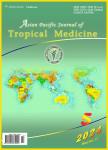Epidemiology and immunodiagnostics of Strongyloides stercoralis infections among migrant workers in Malaysia
Epidemiology and immunodiagnostics of Strongyloides stercoralis infections among migrant workers in Malaysia作者机构:Tropical Infectious Diseases Research and Education Centre(TIDREC)University of Malaya50603 Kuala LumpurMalaysia Department of ParasitologyFaculty of MedicineUniversity of MalayaKuala Lumpur.Malaysia Institute for Research in Molecular Medicine(INFORMM)Universiti Sains Malaysia11800 Pulau PinangMalaysia School of Life SciencesUniversity of NottinghamUniversity ParkNottinghamNG7 2RDUK Institute of Biological ScienceFaculty of ScienceUniversity of MalayaKuala LumpurMalaysia
出 版 物:《Asian Pacific Journal of Tropical Medicine》 (亚太热带医药杂志(英文版))
年 卷 期:2019年第12卷第6期
页 面:250-257页
核心收录:
学科分类:1002[医学-临床医学] 100201[医学-内科学(含:心血管病、血液病、呼吸系病、消化系病、内分泌与代谢病、肾病、风湿病、传染病)] 10[医学]
基 金:funded by University of Malaya,PPP grant(PG040-2014A) Fundamental Research Grant Scheme(FRGS)from Ministry of Higher Education(FP015-2014B) UM/MoHE High Impact Research Grant(UM.C/625/1/HIR/MOHE/MED/23) Universiti Sains Malaysia,Malaysian Ministry of Higher Education grant(HICoE 311/CIPPM/4401005)
主 题:Strongyloides stercoralis Migrant workers Microscopic examination Serological analysis PCR
摘 要:Objective: To investigate the status of Strongyloides(S.) stercoralis infections among migrant workers in Malaysia for the first time and identify risk ***: Four diagnostic methods were employed for the detection of S. stercoralis including microscopy, enzyme-linked immunosorbent assay(ELISA) using a commercial kit, ELISA using the rSs1a antigen and polymerase chain reaction(PCR). Low and semi-skilled workers from five working sectors(i.e. manufacturing, food service, agriculture and plantation, construction and domestic service) were tested on a voluntary basis. Results: The overall seroprevalence of S. stercoralis from 483 workers employing the ELISA commercial kit for IgG was 35.8%(n=173;95% CI: 31.5%-40.1%) whereas seroprevalence using the rSs1a-ELISA was 13.0%(n=63;95% CI: 10.0%-16.0%). Cross tabulation between the ELISA commercial kit and rSs1a-ELISA showed that only 6.4%(n=31;95% CI: 4.2%-8.6%) of the samples were positive in both tests. Microscopic examination of all 388 fecal samples were negative;however subsequent testing by a nested PCR against DNA from the same samples successfully amplified DNA from three male subjects(0.8%;3/388). Male workers, India and Myanmar nationality, food service occupation and those living in the hostel were statistically significant with seroprevalence(P0.005). Conclusion: This is the first report on the epidemiology of S. stercoralis infections among the migrant workers in Malaysia. Our results highlight the importance of using appropriate diagnostic tools for detection. The presence of anti-S. stercoralis antibodies in the study population calls for improvements in personal hygiene and sanitation standards among migrant workers in Malaysia through control strategies including health education campaigns and programs aimed at increasing awareness and healthy behaviors.



